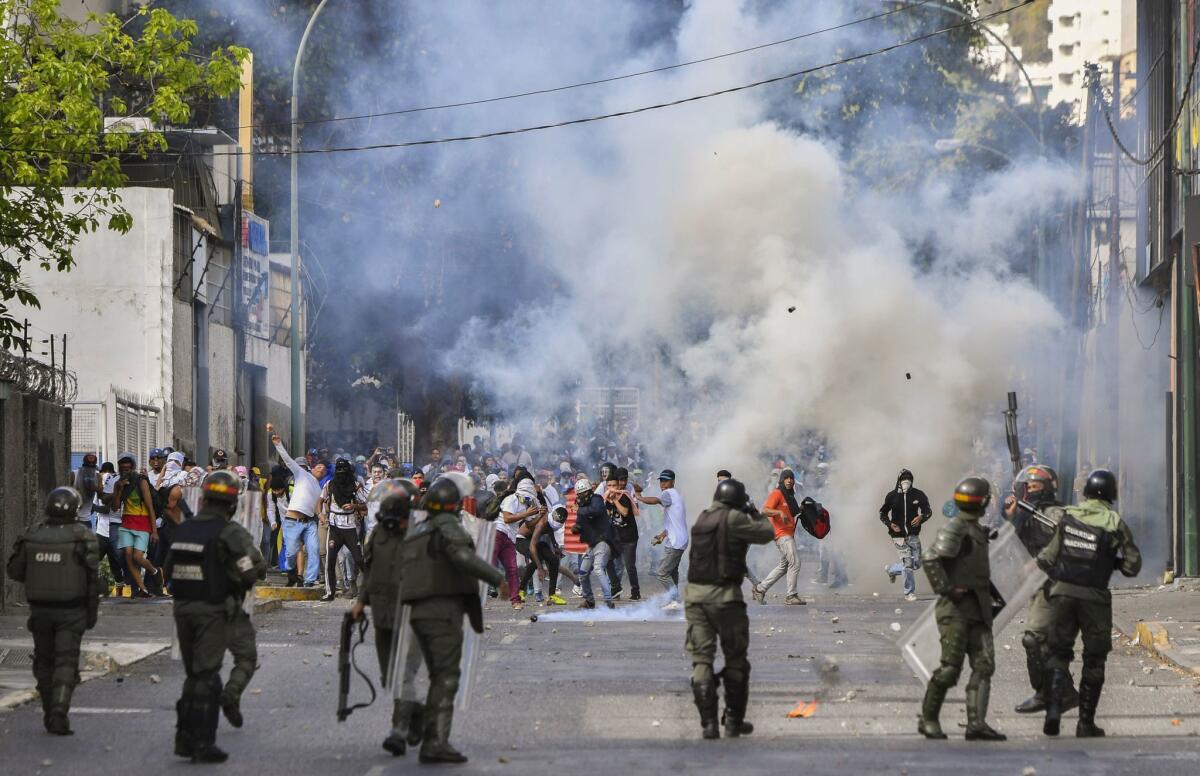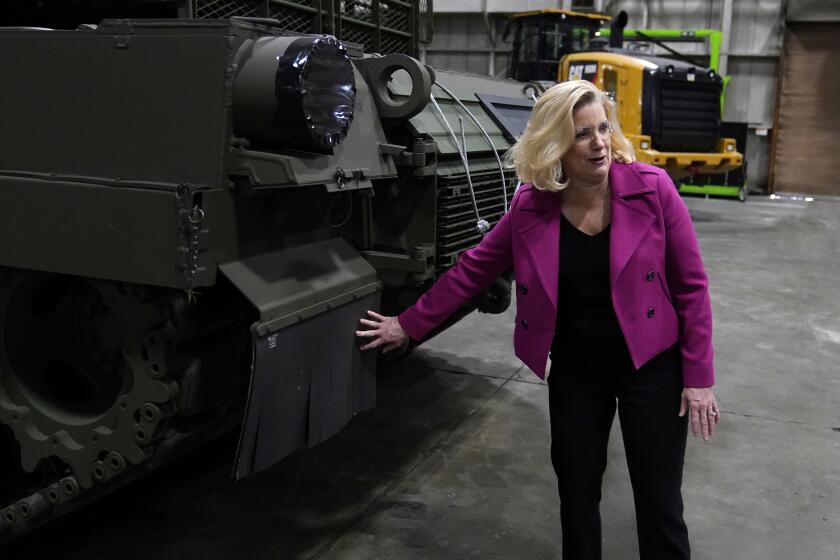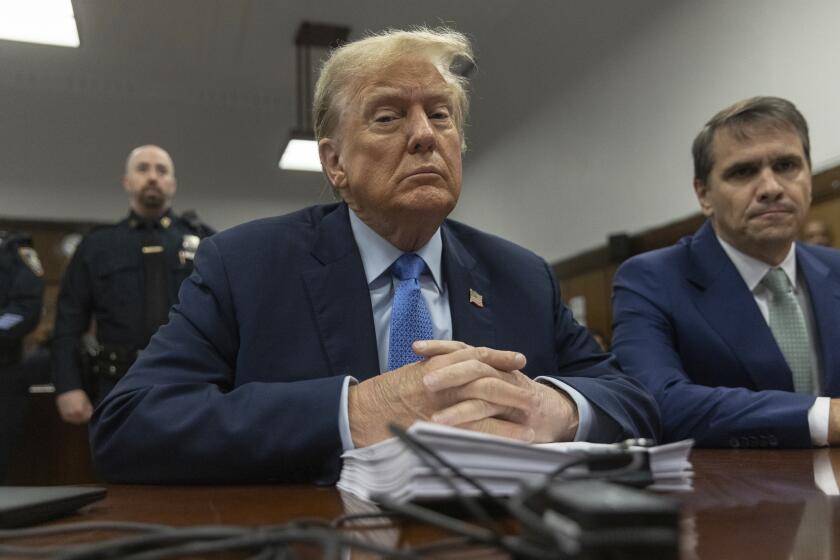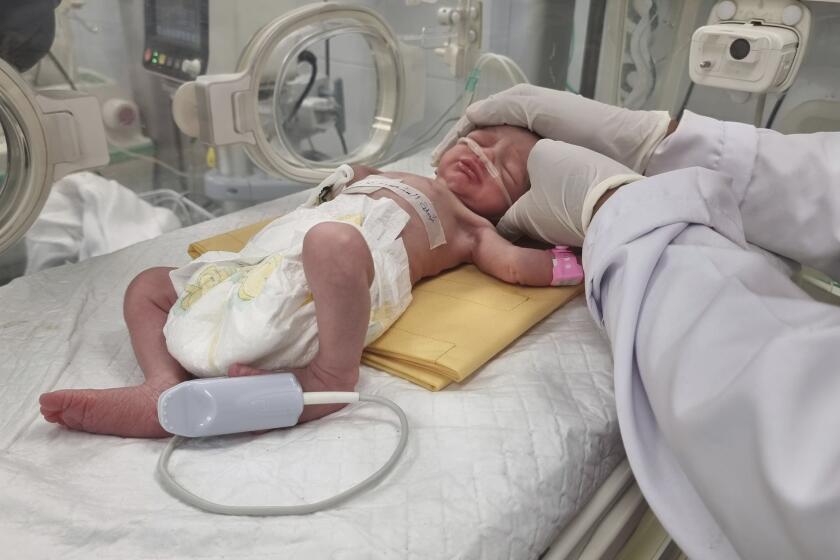Even in barrios once devoted to Hugo Chavez, murmurs of opposition grow in Venezuela

Walls facing the streets still bear faded slogans extolling former President Hugo Chavez, whose arched eyebrows peer from images stenciled outside rundown apartment blocks and barren shops, ghostly hints that someone is still watching.
But the allure of Chavismo, the late president’s socialist policies aimed at vanquishing inequality and spreading prosperity, has waned even here in La Vega — an urban expanse of narrow alleys and ramshackle dwellings gouged into verdant hills in the western edges of this capital city.
La Vega, like other impoverished zones, has been a bastion of support for the ruling socialist party and of the late Chavez’s chosen successor, President Nicolas Maduro.
Both Maduro and Comandante Chavez, as he is still affectionately known by many, long denounced the opposition as the product of bourgeois backlash against the socialist “revolution” launched in the name of long-marginalized masses like the people of La Vega.
Before Venezuela’s economy began to crumble a few years back, generous government allocations of subsidized food and housing, cash payouts and other amenities helped build and maintain a sturdy citadel for Chavez in La Vega and other government strongholds.
On Jan. 23, however, as opposition lawmaker Juan Guaido publicly declared Maduro a “usurper” and proclaimed himself acting president, some La Vega residents descended to the streets in solidarity. A fearsome elite police squad, the Special Action Force, known as FAES, after its Spanish acronyms, violently broke up the anti-government demonstration, residents say.
But the fact that poor people here and elsewhere took to the streets in protest is seen by some as a sign of a grass-roots political shift in this long-polarized South American nation of 32 million.
“This whole barrio used to be Chavista, but not anymore,” said Karina Monterola, 44, who has lived in La Vega since she was a child. “Why? Because there is hunger, a lack of water, all kinds of shortages. … The minimum wage isn’t enough to afford to eat — much less to buy clothing, or even an ice cream for my daughter.”
After the clashes in late January, discontent is still mostly whispered in La Vega, where government loyalists act as informants and enforcers in Cuban-style block associations, according to the opposition. Police in white pickups rumble through the neighborhood’s potholed avenues.
Today, as Venezuela endures the latest and possibly decisive stage of its protracted economic and political crisis, the poor and working-class core of Chavista support appears to be eroding amid mounting hardships.
“The Chavistas are suffering a lot, they are the poorest sector — and now they are even poorer,” political analyst Jesus Seguias said. “They were the backbone of [government] support, and now they feel like they are being laughed at by the government, abandoned. … There has been an immense collapse in support in the bases of Chavismo.”
The government crackdown on incipient protests following Guaido’s declaration of an “interim” government shook not only La Vega, but also other traditionally pro-government zones, including the sprawling Petare district in eastern Caracas. Rioting, looting and clashes between police and demonstrators roiled many poor neighborhoods.

An estimated 40 people were killed nationwide and some 850 detained during late January’s anti-government protests, according to the United Nations, which alleges at least 26 were shot to death by pro-government forces.
After the clashes, “came the repression,” said Monterola, who spoke as she sat in a car meandering through the winding streets of La Vega, pointing out its far-flung settlements — with names like the Towers, the Blocs, the Magicians, the Cement Factory.
“We know there were deaths, but not how many. They took away a lot of young men who haven’t been seen again. Their families don’t know where they are.”
The government has been mostly silent on the violence. But Maduro has traditionally attributed protest casualties to armed and paid opposition provocateurs.
“Don’t come to us with stories about what is happening in los barrios,” Maduro told reporters on Friday. “A group of delinquents was hired, and they’re [now] all prisoners, did you know that? They paid them $100 a day to make violence and the people rejected them. Whoever goes out to make violence will face justice.”
That Maduro blames the country’s economic breakdown on external forces — U.S. sanctions and other moves by Washington that he labels an “economic war” and “blockade” — doesn’t seem to have quelled dissent within the once-solid ranks of Chavismo.
Maduro’s critics say corruption and mismanagement are behind the country’s economic woes.
Chavez, a career military officer from humble origins, was elected president in 1998 on a left-wing, anti-establishment platform, vowing to clean up corruption and make the oil-rich nation a more equitable society. His approach appealed to poor and working-class Venezuelans alienated from the previous two-party system that many viewed as favoring a long-entrenched oligarchy and U.S. oil giants.
With his trademark red beret and rants against U.S. “imperialism,” Chavez soon became a hero of much of the global left and a confidant of Fidel Castro, the late Cuban revolutionary icon.
His first decade in office benefited from a hike in oil prices, providing revenues for a stream of social programs. He died in 2013 and a year later, under acolyte Maduro, oil prices plummeted, presenting a major ongoing challenge. The Trump administration’s decision to slap sanctions on Venezuelan oil sales — the country’s major source of revenue — was designed to hasten the fall of Maduro and of Chavismo.
Yet the frustration evident in La Vega and elsewhere in poor districts appears less a repudiation of the egalitarian principles that Chavez expounded than an expression of desperation about the country’s ever-declining quality of life.
A visitor to La Vega and other struggling enclaves inevitably confronts an all-encompassing weariness — fatigue with chronic shortages, queues for food and medicines, a generalized breakdown of basic services.
Under a blazing sun, residents with haggard faces and tattered clothing trudge up and down the steep hills of La Vega, home to more than 150,000. Public transport is irregular at best; many lack cash to pay for plodding cabs and moto-taxis.
Maduro lacks both his mentor’s charisma and the abundance of oil revenues that helped Chavez spend lavishly to boost living standards. Some prominent ex-Chavez functionaries have publicly broken with the Maduro administration.
Guaido’s ascendance, meantime, has, for now, unified a long-fragmented opposition, but it unclear how long that unity will last..
Even the opposition concedes that Maduro retains a core of popular support — at least 17% of voters, analysts say — who remain loyal to his rule, and to the ideals of Chavez. His free-spending 1999-2013 administration, buoyed by the high oil prices, oversaw a drop in national poverty rates, unemployment and illiteracy.
“One has to recognize that the government, both of Comandante Chavez and that of Nicolas Maduro, have done good things,” said Maria Coromoto Blanco, 42, a La Vega resident and mother of two who runs a small cleaning-supply business and remains a loyal Chavista. “We have access to affordable food. … medical care, cash grants for families. And the government has built homes for the poor. We can go to university and study.”
Pro-government counterprotest brigades inevitably materialize on days of big opposition mobilizations. Some are organized groups of militiamen or motorcycle-riding colectivos, ready to confront what they view as opposition incitement. The opposition dismisses them as mercenaries, but many seem to express genuine loyalty to the government — and a determination that what they view as a U.S.-designed coup, or possible invasion, will not succeed.
“I’m here to fight for the revolution,” Morelia Marquez, 48, a teacher, said as she stood with a group of pro-government demonstrators recently outside the heavily guarded Miraflores presidential compound. “We are prepared to fight, to defend the country.”
Karina Monterola, the longtime La Vega resident, says she has broken with support for Maduro and Chavismo, even though her household is among the millions receiving monthly boxes of subsidized food from the government.
She fears her daughter, 18, might soon join the mass exodus of Venezuelans emigrating from the country. Like others, she says the daily grind is wearing her down.
“I work day and night and the money hardly leaves me enough to live,” said Monterola, who does a day shift as a cashier in a produce shop and works nights as a nurse. “My daughter has no future. She wants to leave. If she does, I would have to go with her. I don’t have anyone else. I can’t afford to lose the one thing, my daughter, that I have in life.”
Mogollon is a special correspondent. Times staff writer Patrick J. McDonnell contributed to this report.
More to Read
Start your day right
Sign up for Essential California for news, features and recommendations from the L.A. Times and beyond in your inbox six days a week.
You may occasionally receive promotional content from the Los Angeles Times.





